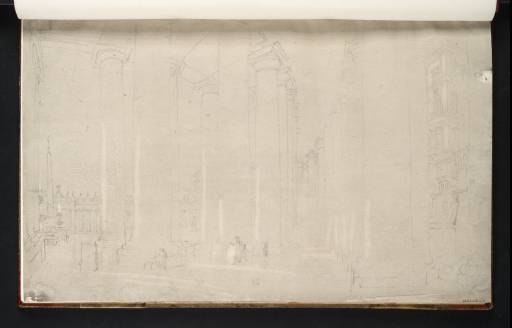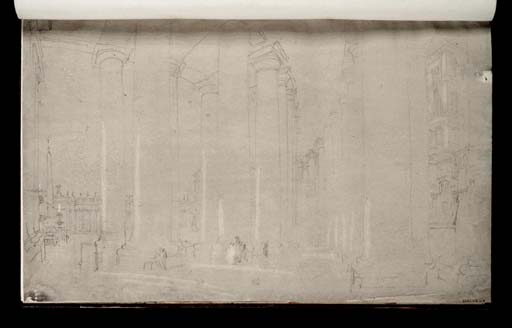Joseph Mallord William Turner The Colonnade of St Peter's, Rome 1819
Image 1 of 2
Joseph Mallord William Turner,
The Colonnade of St Peter's, Rome
1819
Joseph Mallord William Turner 1775–1851
Folio 4 Recto:
The Colonnade of St Peter’s, Rome 1819
D16330
Turner Bequest CLXXXIX 4
Turner Bequest CLXXXIX 4
Pencil and grey watercolour wash on white wove ‘Valleyfield’ paper, 229 x 368 mm
Stamped in black ‘CLXXXIX 4’ bottom right
Stamped in black ‘CLXXXIX 4’ bottom right
Accepted by the nation as part of the Turner Bequest 1856
Exhibition history
1904
National Gallery, London, various dates to at least 1904 (256).
References
1904
E.T. Cook and Alexander Wedderburn (eds.), Library Edition: The Works of John Ruskin: Volume XIII: Turner: The Harbours of England; Catalogues and Notes, London 1904, no.256, pp.378, 622, as ‘The Colonnade of Bernini’ and ‘Rome: The Colonnade of St Peter’s’.
1909
A.J. Finberg, A Complete Inventory of the Drawings of the Turner Bequest, London 1909, vol.I, p.562, as ‘The Colonnade of St. Peter’s. 256, N.G.’.
1920
D[ugald] S[utherland] MacColl, National Gallery, Millbank: Catalogue: Turner Collection, London 1920, p.87.
1968
Luke Herrmann, Ruskin and Turner: A Study of Ruskin as a Collector of Turner, Based on his Gifts to the University of Oxford; Incorporating a Catalogue Raisonné of the Turner Drawings in the Ashmolean Museum, London 1968, p.100 no.87.
1996
Hardy George, ‘Turner, Lawrence, Canova and Venetian art’, Apollo, October 1996, p.32 note 11.
Turner’s viewpoint for this sketch is the northern (right) arm of the two colonnades built by Gian Lorenzo Bernini (1598–1680) to frame the elliptical space in front of the Basilica of St Peter’s. The artist is standing within the colonnade looking out so that his view is partially obscured by three rows of Tuscan columns. In the background on the left can be seen the obelisk which stands in the centre of the piazza and the granite fountain by Carlo Maderno (1556–1629), and beyond this is the straight covered gallery of the Charlemagne Wing. The façade of St Peter’s itself is almost entirely concealed behind the pillars in the centre but visible on the far right is part of the adjacent Apostolic Palace. A composition from a different viewpoint can also be found in the St Peter’s sketchbook (see Tate D16310; Turner Bequest CLXXXVIII 83a). During his youth, Turner made a copy of a similar subject after another artist (see Tate D36528; Turner Bequest CCCLXXV 7).
In common with many of the drawings within this sketchbook Turner has created highlights by scratching or rubbing through the grey watercolour wash to reveal the paper beneath. In this instance he has employed the technique to describe passages of light illuminating the side of the columns and the floor. This lends the composition a greater sense of depth and reinforces the dramatic receding perspective of the colonnade. The artist has also included several small figures huddled at the base of two of the columns, dwarfed by the massive architecture around them. These people are smaller than they would be in reality and therefore introduce a disproportionate sense of scale.
Hardy George has cited this sketch as part of Turner’s unusual interest in Baroque Rome.1 During the nineteenth century the Baroque style was widely perceived to be too excessive and fussy and most visiting artists chose to focus on antique and neo-classical art and architecture. Turner, however, sketched a number of Baroque features including St Peter’s Square, the Trevi fountain (see Tate D16204; Turner Bequest CLXXXVIII 26), and the Piazza del Popolo (see Tate D16381; Turner Bequest CLXXXIX 52).
This drawing was one of a number selected by Ruskin to be exhibited at the National Gallery during the late nineteenth century. A copy dating from this period by an unknown hand was part of the teaching collection donated by Ruskin to the Drawing School at the University of Oxford (now in Ashmolean Museum, Oxford).2
Arcades of St Peter’s, Rome, see Herrmann 1968, p.101, reproduced p.XLV, fig.H. See also http://ruskin.ashmus.ox.ac.uk/catalogue/cat_page.php?id=WA.RS.SUP.179 , accessed July 2009 and E.T. Cook and Alexander Wedderburn (eds.), Library Edition: The Works of John Ruskin: Volume XXI: The Ruskin Art Collection at Oxford, London 1906, p.306 no.179.
Verso:
Blank, except for traces of grey watercolour wash; stamped in black ‘CLXXXIX 4’ bottom left.
Nicola Moorby
July 2009
How to cite
Nicola Moorby, ‘The Colonnade of St Peter’s, Rome 1819 by Joseph Mallord William Turner’, catalogue entry, July 2009, in David Blayney Brown (ed.), J.M.W. Turner: Sketchbooks, Drawings and Watercolours, Tate Research Publication, December 2012, https://www


